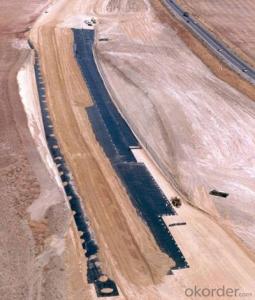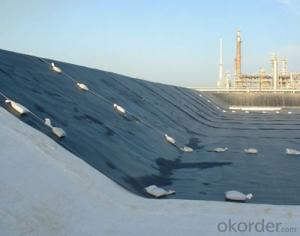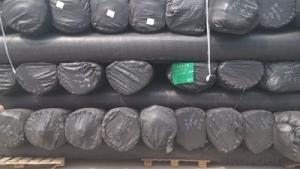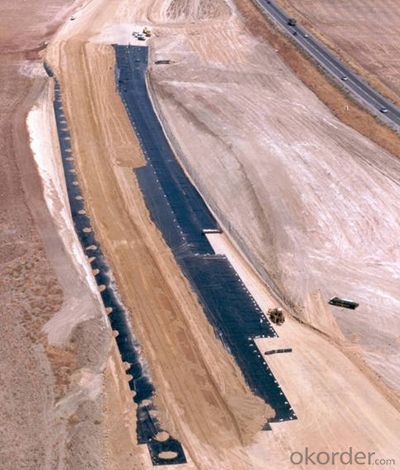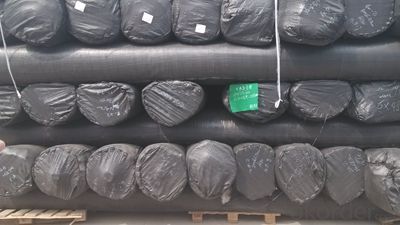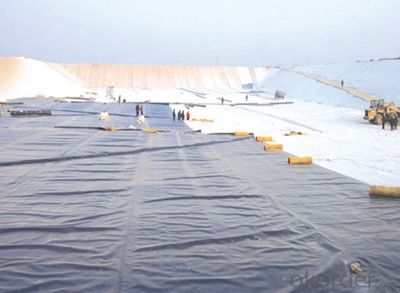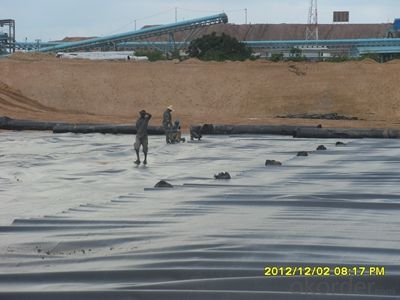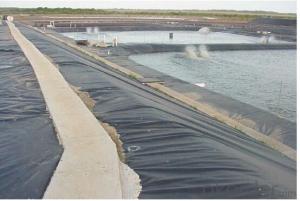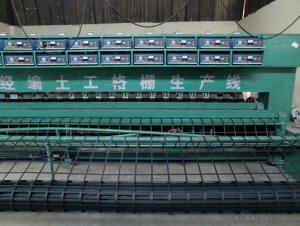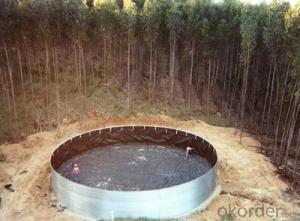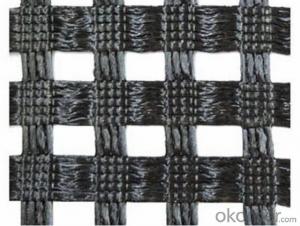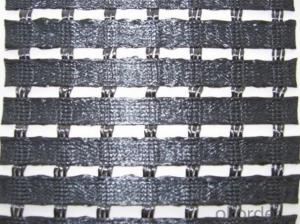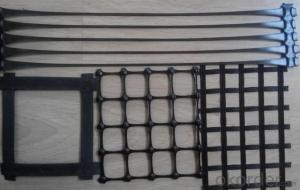Triax Geogrids Reinforced HDPE Textured Geomembrane for River Tunnel Canal
- Loading Port:
- Tianjin
- Payment Terms:
- TT OR LC
- Min Order Qty:
- 88 m²
- Supply Capability:
- 1800000 m²/month
OKorder Service Pledge
OKorder Financial Service
You Might Also Like
The structure of HDPE Textured Geomembrane for River tunnel canel description :
One side or two sides uniformly textu red surface by special blow technology.
Specification of HDPE Textured Geomembrane for River tunnel canel:
I. Thickness: 1.0mm t0 3. 0mm
2.4m-9m in width, roll length as design or client ' s request
Feature of Property of HDPE Textured Geomembrane for River tunnel canel:
I. High flexibility, high waterproof coefficient
2. Could be used in the temperature of -700C - IIOoC
3. Good stability, anti acid and alkalis, anti-erosion
4. High climate bearing ability, excellent in anti-aging
5. High tensile strength and elongation, can be used in bad geology and climate, especially be
Used in the soil uneven sedimentation
6. High friction coefficient
Application of HDPE Textured Geomembrane for River tunnel canel:
I. M unicipal p rojects
2. Landfill treatment projects
3. Waste water treatment
4. Mineral waterproofing
Production standard of HDPE Textured Geomembrane for River tunnel canel:
I. GB/T17643-2011 ( GH-2T1 and GH-2T2 )
2. CJ/T234-2006
3. GRI-GMB
Area |
|
Hydraulic | Lagooning and Water Treatment, Ornamental Ponds, Golf Courses Aquaculture and Desalination Water LagoonsTanks, Reservoirs, Liquid WasteFloating Cover SolutionsDrainage and FiltrationShading Cover Solutions |
Environment | Tailing ponds, Leach mining,Landfills,Landfill Capping,Protection against corrosion,Vertical Barriers |
Civil Works | Erosion Control, Secondary Containment, Tunnels,Linear and Surface Works,Consolidation of Margins,Soil Reinforcement,Soil Separation. |
Building | Parkings,Roofing,Soundproofing building |
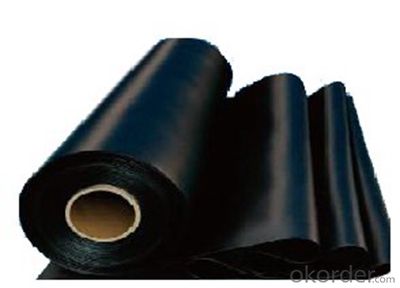
Introduction of CNBM
China National Building Materials (Group) Corporation (CNBM) is a state-owned enterprise in charge of administrative affairs in China building materials industry. Established in 1984, CNBM is a large group corporation of building materials with total assets of RMB 25 billion and a total staff of 30,000. Now CNBM owns more than 200 subsidiaries in and abroad the country, including wholly-owned corporations and joint ventures.
FAQ of geosynthetics :
What is geosynthetics ?
Geosynthetics form a perfect erosion control fabric used extremely widely in civil engineering to stabilize and reinforce slopes and soil under or next to roads, railways, dams, water reservoirs etc.. They can be easily applied which minimizes the time of construction, as well as they limit the resources and materials necessary.
What kinds of geosynthetics we have ?
Non-woven geotextile, geogrids, geocells, GCL, Geomembranes, Geonets, Geocomposites etc .
What is the geosynthetics used for ?
Hydraulic
Lagooning and Water Treatment, Ornamental Ponds, Golf Courses
Aquaculture and Desalination,Water Lagoons,Tanks, Reservoirs, Liquid Waste,Floating Cover Solutions, Drainage and Filtration
Environment
Tailing ponds, Leach mining,Landfills,Landfill Capping,Protection against corrosion,Vertical Barriers
Civil Works
Erosion Control,Secondary Containment,Tunnels,Linear and Surface Works,Consolidation of Margins,Soil Reinforcement,Soil Separation.
Building - Parkings,Roofing,Soundproofing
- Q: Can geogrids be used for retaining walls?
- Yes, geogrids can be used for retaining walls. Geogrids are commonly used in the construction of retaining walls to provide additional stability and reinforcement to the soil. They help distribute the load and prevent the soil from shifting, improving the overall strength of the wall.
- Q: How do geogrids improve the load-bearing capacity of foundations?
- Geogrids improve the load-bearing capacity of foundations by providing reinforcement and stability to the soil. These geosynthetic materials are placed within the soil layers and their interlocking geometry creates a more rigid and compact structure. This helps distribute the load evenly across a wider area, reducing the risk of settlement and increasing the overall strength of the foundation.
- Q: Bi directional plastic geogrid is suitable for engineering
- Wharf cargo yard and other permanent bearing foundation reinforcement.Supply geogrid.
- Q: The difference between composite geomembrane and bentonite waterproof blanket
- Different waterproof performance. Composite geomembrane: composite geomembrane composite impermeable membrane is divided into one cloth and two membrane. Tensile, tearing resistance, bursting and other physical and mechanical properties of high index, the product has high strength, good elongation, deformation modulus, acid and alkali resistance, corrosion resistance, aging resistance, good performance of seepage control, etc..
- Q: Are geogrids resistant to freeze-thaw cycles?
- Yes, geogrids are generally resistant to freeze-thaw cycles. Their high tensile strength and flexibility allow them to withstand the expansion and contraction caused by freezing and thawing without significant damage. This makes geogrids an effective solution for stabilizing soil and preventing erosion in cold climates.
- Q: Can geogrids be used in ground improvement projects?
- Yes, geogrids can be used in ground improvement projects. Geogrids are commonly used to reinforce and stabilize soil, improving its bearing capacity and preventing soil erosion. They are effective in a variety of ground improvement applications such as road construction, retaining walls, and slope stabilization.
- Q: Are geogrids suitable for reinforcing concrete slabs?
- Yes, geogrids are suitable for reinforcing concrete slabs. Geogrids provide excellent tensile strength and stability, reducing cracking and enhancing load distribution in concrete slabs. They also improve the overall durability and longevity of the slabs, making them a reliable choice for reinforcement.
- Q: What is the effect of strain rate on geogrid behavior?
- The effect of strain rate on geogrid behavior is that it can significantly impact the mechanical properties and performance of the geogrid. At higher strain rates, the geogrid may exhibit increased stiffness and strength due to the rate-dependent nature of its materials. This means that the geogrid can better resist deformations and provide enhanced stability under dynamic loading conditions. However, at extremely high strain rates, the geogrid may experience reduced performance and even failure due to excessive stress concentrations and insufficient time for dissipation of energy. Thus, understanding and considering the strain rate is crucial in designing and applying geogrids for different applications.
- Q: What is the effect of installation damage on geogrid performance?
- Installation damage can have a significant impact on geogrid performance. When geogrids are improperly installed or handled, they can sustain damage such as tears, punctures, or stretching. These damages can weaken the geogrid's structural integrity and compromise its ability to provide reinforcement and stabilization in soil or aggregate applications. As a result, the geogrid may not be able to withstand the intended loads and stresses, leading to reduced performance and potential failure of the geosynthetic system. Therefore, proper installation techniques and careful handling are crucial to ensure optimal geogrid performance and longevity.
- Q: What type of geogrid is CATTXDJ?
- 1 Introduction geogrid: Geogrid geogrid is a kind of main geosynthetics, which has unique properties and effects compared with other geosynthetics. Geogrid is often used as reinforcement of reinforced soil structure or composite material. Geogrid is divided into four categories: plastic geogrid, steel plastic geogrid, fiberglass geogrid and polyester warp knitted polyester geogrid. 2 classification of plastic woven through the formation of a square or rectangular polymer mesh material, according to the direction of its manufacturing can be different for different types of uniaxial tension and biaxial tensile two
Send your message to us
Triax Geogrids Reinforced HDPE Textured Geomembrane for River Tunnel Canal
- Loading Port:
- Tianjin
- Payment Terms:
- TT OR LC
- Min Order Qty:
- 88 m²
- Supply Capability:
- 1800000 m²/month
OKorder Service Pledge
OKorder Financial Service
Similar products
Hot products
Hot Searches
Related keywords
